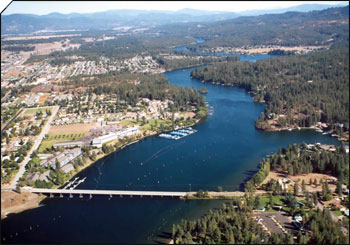
Moving to Post Falls, Idaho: A Comprehensive Relocation Guide
Considering moving to Post Falls, Idaho? This growing Kootenai County city offers family atmosphere, convenient Spokane access, and North Idaho lifestyle. With approximately 42,000 residents in 2025, Post Falls combines explosive growth with proximity to Coeur d’Alene and the Idaho-Washington border’s booming community.
Demographic Profile to Consider If Moving to Post Falls:
Post Falls’ 2025 population is approximately 42,000 residents in this rapidly growing Kootenai County city along the Spokane River near the Washington border. The median age is around 37 years, with families, professionals working in Spokane, and transplants from Washington. The population is approximately 90% White, 6% Hispanic, 2% Native American. Post Falls features extensive new residential development, retail centers, the Spokane River providing recreation, and proximity to both Coeur d’Alene (10 minutes) and Spokane, Washington (20 minutes). The city attracts families seeking affordability compared to Coeur d’Alene, Washington residents fleeing that state’s taxes, and those wanting North Idaho lifestyle with Spokane employment access. Post Falls appeals to families, commuters, and those prioritizing value with convenient location. The community experiences explosive growth and development. Find trusted local services for moving, living, and working in Post Falls.Post Falls Relocation Directory
Cost of Living to Consider If Moving to Post Falls:
Post Falls offers moderate costs lower than Coeur d’Alene but rising with growth. Median home values range from $450,000 to $600,000 in 2025, more affordable than Coeur d’Alene while providing North Idaho access and no Washington income tax. The median household income is approximately $72,000. Rental properties average $1,500 to $2,200 monthly. Idaho’s state income tax is flat 5.8% (but still lower than Washington’s rates). Overall cost of living reflects rapid growth and proximity to Coeur d’Alene resort area. Post Falls attracts Washington residents escaping higher costs and taxes, families seeking affordability, and commuters to Spokane. Housing costs create relative value compared to Coeur d’Alene while maintaining North Idaho access. The explosive growth drives development and rising prices.
Economy and Job Market:
Post Falls residents typically work in Spokane, Coeur d’Alene, or at local employers. Many commute to Spokane for professional employment benefiting from Idaho’s lower taxes while accessing Washington jobs. Retail centers along Idaho Highway 41 create service employment. Amazon operates a fulfillment center. Buck Knives manufactures in Post Falls. Healthcare and schools provide jobs. The broader Spokane-Coeur d’Alene economy offers opportunities. Typical commute times to Spokane range 25-40 minutes, to Coeur d’Alene 10-15 minutes. The city serves as a bedroom community for both markets. The location on the state border attracts Washington workers seeking lower Idaho taxes.
Education:
Post Falls School District serves city students with schools including Post Falls High School and various elementary and middle schools. School quality is competitive with growing enrollment. North Idaho College campuses are accessible. The educational infrastructure expands continuously to serve explosive population growth with new schools opening regularly.
Recreation and Lifestyle:
Post Falls offers Spokane River recreation with Q’emiln Park providing trails, river access, and the Post Falls Dam. Residents enjoy Falls Park and extensive trail systems. The nearby Centennial Trail connects to Coeur d’Alene and Spokane providing 60+ miles of paved recreation paths. Silverwood Theme Park (15 minutes) offers family entertainment. Residents access Coeur d’Alene Lake (15 minutes), skiing at Schweitzer Mountain and Silver Mountain, and North Idaho outdoor recreation. The lifestyle emphasizes family activities, outdoor recreation, new home amenities, and convenient access to both Coeur d’Alene resort area and Spokane employment/shopping. The four-season climate enables year-round activities. The community values family atmosphere, growth, proximity to amenities, and avoiding Washington taxes. Living in Post Falls means embracing explosive growth (construction everywhere, traffic increasing, rapid change), suburban character, and serving as bedroom community while enjoying North Idaho beauty with Spokane and Coeur d’Alene proximity creating ideal location for commuters.
Healthcare and Services:
Post Falls residents access healthcare through facilities in Post Falls and nearby Kootenai Health in Coeur d’Alene. Spokane’s extensive healthcare infrastructure is easily accessible. The regional medical resources provide comprehensive care.
Transportation:
Post Falls is accessed via Interstate 90, Idaho Highway 41, and connecting routes. Spokane International Airport is approximately 25 minutes west. Citylink Transit provides limited bus service connecting to Coeur d’Alene. Most residents use personal vehicles. Typical commute times to Spokane or Coeur d’Alene are reasonable with traffic increasing as the area grows.
Conclusion:
Moving to Post Falls in 2025 offers booming North Idaho living with family atmosphere, Spokane access, and Coeur d’Alene proximity. The city’s combination of explosive growth, border location, and dual-market access makes it ideal for families, Washington tax refugees, and commuters seeking North Idaho lifestyle where affordability meets convenience and strategic location defines the Idaho-Washington border’s fastest-growing community.

